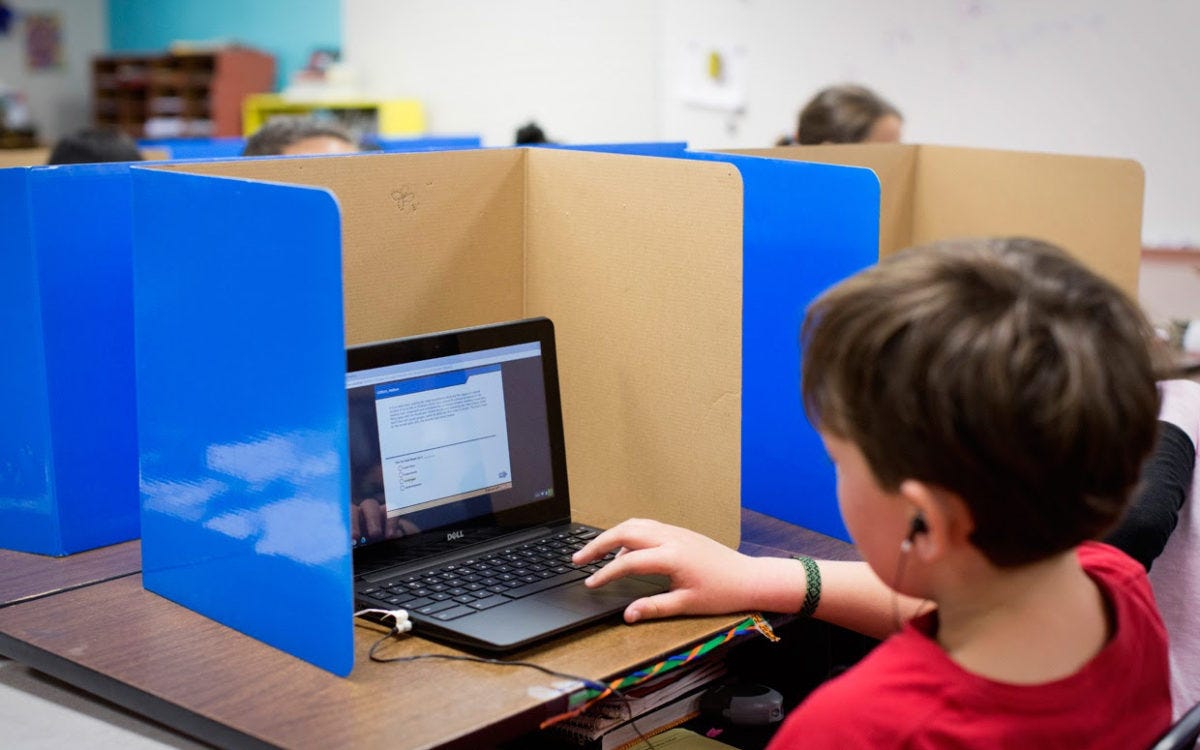In 2016, many families cast their ballots for the first female president and were charged with hope and dreams of the way a woman in the White House would change how upcoming generations viewed and engaged in our democracy. The outcome of the election felt jarring, for many, like the ending to a deeply moving movie that replays in your head over and over. At the time, my daughter who was in kindergarten, was involved in our dinner conversations about the election. So, I spent quite a bit of time explaining the outcome to her, about our democratic process, and why I would get teary-eyed in the car listening to news.
This weekend it occurred to me that 2016 wasn’t the end of the story, because there was a deep sense of resolve and relief watching Kamala Harris introduce Joe Biden on Friday evening. The collective exhale felt by many signified it was time to move forward. My, now fourth grade, daughter (a civic-minded child who suggested we celebrate with ice-cream sundaes on Saturday) found me crying in the kitchen this weekend over a Twitter post about Kamala and asked if everything was alright. That was my moment of relief when I finally exhaled, wrapped my arms around her, and we both watched the video flipping through all of the previous vice presidents— and then Madame Vice President-Elect, Kamala Harris:
“…every little girl watching tonight sees that this is a country of possibilities, and to the children of our country, regardless of your gender, our country has sent you a clear message: Dream with ambition, lead with conviction and see yourselves in a way that others may not, simply because they've never seen it before. But know that we will applaud you every step of the way.”
STATE AND LOCAL EDUCATION POLICY
Transparency and trust are cornerstones for policy implementation, especially when policies derive from contentious public narratives. While some successful local measures across the country will face such feats, many were passed because they were born from innovation and community-driven support. Both Cleveland, Ohio and Portland, Oregon built strong coalitions around education policy for equitable and affordable preschool, accessibility to digital learning, and equal pay for early childhood educators.
While some successful local measures across the country will face such feats, many were passed because they were born from innovation and community-driven support. @cmtpitts @cleometroschools @the74 #edpolicyhotlist
Washington approves Referendum 90 on sex health education in schools in early returns | WA
High-Stakes Day for Cleveland: District CEO Warns of Drastic Cuts If $23M Tax Hike Fails | The74
What this Oregon county’s “preschool for all” victory means for child care in America | Vox
Washington is buying $24M worth of computer technology for students | The Seattle Times
FEDERAL FUNDING AND NATIONAL POLICY
Many are trying to make sense of what was and what will be in education policy with federal transition planning. Many are questioning the legitimacy and livelihood of recent federal policies, especially rhetoric that has tightened spending. Even bigger questions lay at bay about the education-specific strategic plans coming from Biden’s kitchen cabinet, the potential picks for the secretary of education position, and the short term needs for additional federal COVID relief.
Even bigger questions lay at bay about the education-specific strategic plans coming from Biden’s kitchen cabinet, the potential picks for the secretary of education position, and the short term needs for additional federal COVID relief. @cmtpitts @futureedgu @thomas_toch #edpolicyhotlist
Ed experts reflect on long-term impact of Trump K-12 policies | The74
Strategies for the next President: To strengthen public education | FutureEd
With DeVos out, Biden plans series of reversals on education | The Washington Post
POLITICS
The presidential election was a relief for many, but to overcome the persistent instability among our communities we need to first diagnose the underlying illness. State and local politics will have a large influence on education policy for the foreseeable future, taking center stage over the national policy churn. The results of our local elections were divided and over the course of the next four years we must first understand and build capacity to heal the political divisions across our nation.
State and local politics will have a large influence on education policy for the foreseeable future, taking center stage over the national policy churn. @cmtpitts @educationgadfly @arotherham #edpolicyhotlist
Democrats expand Senate map, putting GOP on defense | The Hill
Three gubernatorial contests with important ed implications | Fordham
On the Trail: Five House results illustrate a politically divided America | The Hill
The looming shake-up of Senate Republican chairmen | POLITICO
ASSESSMENT AND ACCOUNTABILITY
Our communities are strong, but the symptoms of our national education system are striking. Pre-covid reading and math scores released last month indicate that 40% of our students are below NAEP Basic in math and 30% of our students are below NAEP Basic in reading. Outcome data, like these, are critical for recalibrating the public accountability system that uses educational data to inform and empower our students, families, and taxpayers. While many education leaders and researchers remain unclear about the short and long term steps for assessment this year, some are considering narrowing in on measuring opportunity-to-learn data, while others are considering reduced blueprints for summative assessments. Either way, we must have conversations about the function of assessments as a part of maintenance of equity provisions across the nation.
Outcome data, like these, are critical for recalibrating the public accountability system that uses educational data to inform and empower our students, families, and taxpayers. @cmtpitts @IESResearch @NathanDadey @ScottFMarion @NCIEA1 #edpolicyhotlist
Toward a Framework for Public Accountability in Education Reform | Hutt & Polikoff
California to consider shorter Smarter Balanced tests this spring | EdSource
TEACHING AND LEARNING
A new study released by RAND sounded an alarm: there is great variability in coherence among ELA curriculum, instruction, and assessments, with Louisiana reporting the greatest coherence. Author, Morgan Polikoff, noted that many teachers aren’t receiving the curriculum-oriented professional learning opportunities necessary to establish coherence. In the context of the pandemic and post-pandemic era, state policymakers must consider both the role of curriculum and coherence, while also addressing the immediate concerns around student engagement and achievement. The Annenberg Institute has established a new initiative to and coalition to build capacity for high-quality tutoring across the nation the National Student tSupport Accelerator
In the context of the pandemic and post-pandemic era, state policymakers must consider both the role of curriculum and coherence, while also addressing the immediate concerns around student engagement and achievement. @cmtpitts @RANDCorporation #edpolicyhotlist
Relationships, equity remain essential for curriculum to connect in remote learning | Education Dive
Exploring Coherence in English Language Arts Instructional Systems in the Common Core Era | RAND
REOPENING SCHOOLS
With COVID-19 cases rising in many communities the decision to return to hybrid or in-person learning is as confusing as ever. The District of Columbia made the decision to slow their return to in-person learning, now opening their doors to only 14k Prek-5th grade students who will attend “virtual” learning while supervised by a non-credentialed staff member in school buildings. Philadelphia is planning to reopen schools for a hybrid model as of November 30th to Prek-2nd grade students. The decision is made in large part due to the low risk of transmission for younger students and the safety procedures they believe they can put in place.
With COVID-19 cases rising in many communities the decision to return to hybrid or in-person learning is as confusing as ever. @cmtpitts @dcpschancellor #edpolicyhotlist
UPCOMING EVENTS
Tuesday, November 10 (2:00 PM EST) WestEd webinar on Perspectives on Formative Assessment, Student Agency and Equity: Ambitious Teaching and formative Assessment: Creating Conditions for Equity
Tuesday, November 10 (3:30 PM EST) WestEd webinar onPursuing Equitable Outcomes: Exploring the Intersection of Race and Disability in K-12
Thursday, November 12 (7:00 PM EST) Hunt Institute webinar on Post-Election 2020: Charting a Path Forward in Education.
Thursday, November 12 (2:00 PM EST) Advance CTE webinar on The State of CTE: An Analysis of State Perkins V Priorities.
Thursday, November 12 (5:00 PM EST) Bright Horizons and the National Head Start Association are hosting an event on promoting Black and Brown leaders in ECE.
Thursday, November 12 (1:30 PM EST) Learning Policy Institute will host a webinar titled Closing California’s Opportunity Gap: Ensuring All Students Have Access to Fully Prepared Teachers
Thursday, November 12 (4:00 PM EST) AASA, NASEP, CCSSO, New America, and NAECS hosting Collaborate to Improve Teaching and Learning.
Thursday, November 19 (4:00 PM EST) AASA, NASEP, CCSSO, New America, and NAECS hosting Coordinate Comprehensive Services.
Thursday, December 3 (4:00 PM EST) AASA, NASEP, CCSSO, New America, and NAECS hosting Partner with Families.
Thursday, December 10 (4:00 PM EST) AASA, NASEP, CCSSO, New America, and NAECS hosting Lead strategically and Continuously Improve.
Dr. Christine M. T. Pitts serves as Manager of Research and Evaluation at Portland Public Schools. As an Oregonian, raised by a multicultural family of educators, she brings a decade of progressive strategic leadership experience, a transformative vision, and analytic skill to crafting state education policy. An educator and researcher by training, she has conducted legislation, governance, and policy analyses on a wide array of education issues using social network analysis and mixed methods research. In addition, Dr. Pitts is a facilitative leader who deeply understands and co-constructs local and national partnerships and convening across stakeholder groups. Dr. Pitts currently coordinates between state and national policy leaders to investigate and advocate for policies that prioritize equity in education. Christine lives with her husband and four children in Portland, Oregon. Follow her on Twitter @cmtpitts.









